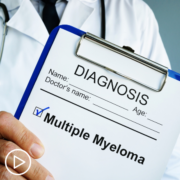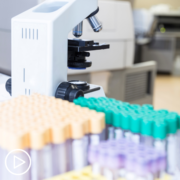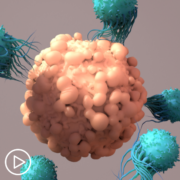Expert Perspective: Why Myeloma Patients Should Weigh in on Their Care Decisions
Expert Perspective: Why Myeloma Patients Should Weigh in on Their Care Decisions from Patient Empowerment Network on Vimeo.
Myeloma specialist Dr. Abdullah Khan shares key advice encouraging patients to participate in care and treatment decisions and discusses the importance of communicating symptoms and side effects to your healthcare team.
Dr. Abdullah Khan is a hematologist specializing in multiple myeloma and plasma cell disorders at the Ohio State University Comprehensive Cancer Center – The James. Dr. Khan is also an assistant professor in the Division of Hematology at The Ohio State University. Learn more about Dr. Khan.
See More from Engaging in Myeloma Treatment Decisions
Related Resources:

|

|

|
Transcript:
Katherine:
Let’s turn to decision-making, Dr. Khan. What is the role of the myeloma patient when making care and treatment decisions?
Dr. Khan:
As a provider, my role is to inform the patient of the facts and the need for a decision. The purpose of the discussions is to determine the patient’s goals and preferences, because it’s essential the patient’s values of respected. The best outcomes occur when the medical facts align with the patient’s preferences. And this is a multi-disciplinary team approach.
Katherine:
Why is it so important for patients to share any symptoms and side effects they’re having with their healthcare team?
Dr. Khan:
I read something recently on an NIH website titled “What Do I Need To Tell the Doctor?” that I think answers this question well. And I’m quoting the article. “Talking about your health means sharing information about how you feel physically, emotionally, and mentally. Knowing how to describe your symptoms and bringing up other concerns will help you become a partner in your healthcare.”
I think I really like that end, “partner in your healthcare.” The patient’s symptoms and suggest disease or disorder in the body. If there are concerns, this may prompt a clinic visit or the patient may be advised to go to the closest ER or urgent care depending on the urgency of the situation. But in other cases, the healthcare team may help provide reassurance that the symptom can be continued to be monitored more resolution, or it can be evaluated in more detail if it persists or worsens.
Katherine:
What about side effects? Why is that important for patients to share any side effects they may be having?
Dr. Khan:
Side effects may be a result of the disease itself. It might be a marker of the side effects from the treatment. Or I’m focused on the multiple myeloma, but there’s every other organ system in the body that also needs help. So, the myeloma might be doing okay. The treatment might be doing okay. But, for example, we might have a lung toxicity from their pre-existing COPD or a heart toxicity from their pre-existing coronary artery disease. So, it’s very important to share all symptoms So, we can see how to properly assess it.
Katherine:
And better care for the patient.
Dr. Khan:
Right.


















